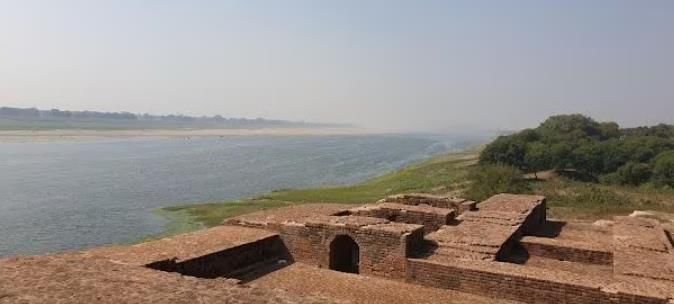Unit Test ( Solutions): New Beginnings : Cities and States | Social Science Class 7 - New NCERT PDF Download
Attempt all questions. Time: 1 hour, M.M. 30
- Question numbers 1 to 5 carry 1 mark each.
- Question numbers 6 to 8 carry 2 marks each.
- Question numbers 9 to 11 carry 3 marks each.
- Question numbers 12 to 13 carry 5 marks each.
Q1. What does the term 'janapada' mean in Sanskrit? (1 Mark)
a) Land of rivers
b) Where people have set foot
c) City of kings
d) Place of trade
Ans : b) Where people have set foot
'Janapada' in Sanskrit means 'where the people (jana) have set foot (pada)', referring to a territory where people settled.
Q2. Which of the following was a powerful Mahajanapada? (1 Mark)
a) Kalinga
b) Avanti
c) Chola
d) Pandya
Ans : b) Avanti
Avanti was one of the most powerful mahajanapadas, along with Magadha, Kosala, and Vatsa.
Q3. What was the primary metal used for the first coins in India? (1 Mark)
a) Gold
b) Copper
c) Silver
d) Iron
Ans : c) Silver
The first Indian coins, called punch-marked coins, were made of silver.

Q4. Which trade route connected the northwest to the Ganga plains? (1 Mark)
a) Dakshinapatha
b) Uttarapatha
c) Eastern Route
d) Southern Route
Ans: b) Uttarapatha
Uttarapatha was a major trade route connecting the northwest to the Ganga plains and eastern India.
Q5. What was the capital city of the Vatsa mahajanapada? (1 Mark)
a) Rajagriha
b) Kausambi
c) Pataliputra
d) Ujjain
Ans : b) Kausambi
Kausambi was the capital of the Vatsa mahajanapada.

Q6. Why were the Ganga plains important for the growth of mahajanapadas? (2 Marks)
Ans : The Ganga plains were fertile, supporting agriculture, and had access to iron ore in nearby mountains, aiding tool-making. These factors increased wealth and population, helping mahajanapadas grow.
Q7. What was the role of the sabhā or samiti in the governance of a janapada? (2 Marks)
Ans : The sabhā or samiti was an assembly of elders in a janapada that discussed clan matters. The rājā took advice from this assembly to govern.
Q8. Name two sources that provide evidence of urban centres during India’s Second Urbanisation. (2 Marks)
Ans : Archaeological excavations uncover city ruins, and ancient literature, such as late Vedic, Buddhist, and Jain texts, describe urban centres.
Q9. What is meant by the Second Urbanisation of India? (3 Marks)
Ans: The Second Urbanisation of India refers to a significant period of urban growth that began in the 1st millennium BCE. This phase followed the decline of the Harappan civilisation and included:
- The establishment of fortified cities in the Ganga plains and surrounding areas.
- The development of extensive trade networks.
- The introduction of new technologies, particularly iron tools.
- A gradual evolution of urban life that has continued into modern times.
Q10. Describe the varna system and list the four varnas. (3 Marks)
Ans: The varna system categorised society into four main groups based on their roles:
- Brahmins: Priests and scholars responsible for religious rituals and education.
- Kshatriyas: Warriors and rulers tasked with protecting and governing society.
- Vaishyas: Traders and farmers who contributed to the economy through commerce and agriculture.
- Shudras: Artisans and workers who provided essential services and crafts.
Q11. How did iron metallurgy contribute to the growth of the mahajanapadas? (3 Marks)
Ans : Iron metallurgy significantly contributed to the growth of the mahajanapadas through several key advancements:
- Stronger tools: Iron tools improved farming efficiency, leading to increased agricultural output.
- Better weapons: The production of sharper weapons, such as swords and spears, enhanced defence and warfare capabilities.
- Urban stability: These advancements supported the development of larger, stable urban centres.
Q12. Explain the differences between the political systems of monarchies and ganas/sanghas in the mahajanapadas. (5 Marks)
Ans :
- Monarchies (e.g., Magadha, Kosala, Avanti) had a hereditary rājā as the supreme authority.
- Rājā in monarchies collected taxes, maintained law and order, and built fortifications and armies.
- Ganas/sanghas (e.g., Vajji, Malla) were democratic, with the sabhā or samiti holding decision-making power.
- In ganas/sanghas, decisions were made through discussion and voting, including selecting or removing the rājā.
- Monarchies relied on a single ruler, while ganas/sanghas emphasised collective governance.
Q13. Discuss why the janapadas and mahajanapadas were important in India’s early history, focusing on their role in urbanisation and trade. (5 Marks)
Ans : The janapadas and mahajanapadas played a crucial role in India's early history for several reasons:
- The janapadas were smaller regions led by a rājā and an assembly, which later merged into larger mahajanapadas around the 8th to 7th centuries BCE, marking the beginning of organised states.
- Major mahajanapadas, such as Magadha and Avanti, established fortified cities, contributing to the phenomenon known as the Second Urbanisation.
- They introduced silver punch-marked coins, which enhanced trade networks and increased wealth.
- The use of iron tools improved agriculture and warfare, supporting population growth and the stability of cities.
- Trade routes like Uttarapatha and Dakshinapatha connected various regions, facilitating the exchange of goods, ideas, and culture, which shaped early Indian civilisation.
|
23 videos|204 docs|12 tests
|
FAQs on Unit Test ( Solutions): New Beginnings : Cities and States - Social Science Class 7 - New NCERT
| 1. What are some key factors that contribute to the growth of cities? |  |
| 2. How do states influence the development of cities? |  |
| 3. What is the significance of cultural diversity in cities? |  |
| 4. What challenges do cities face due to rapid urbanization? |  |
| 5. How can cities promote sustainable development? |  |






















